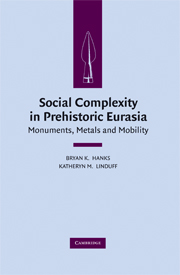Book contents
- Frontmatter
- Contents
- Contributors
- Foreword: From Myth to Method: Advances in the Archaeology of the Eurasian Steppe
- CHAPTER 1 Introduction: Reconsidering Steppe Social Complexity within World Prehistory
- PART ONE FRAMING COMPLEXITY
- CHAPTER 2 Introduction
- CHAPTER 3 Differentiated Landscapes and Non-uniform Complexity among Bronze Age Societies of the Eurasian Steppe
- CHAPTER 4 The Sintashta Genesis: The Roles of Climate Change, Warfare, and Long-Distance Trade
- CHAPTER 5 Settlements and Cemeteries of the Bronze Age of the Urals: The Potential for Reconstructing Early Social Dynamics
- CHAPTER 6 The Maikop Singularity: The Unequal Accumulation of Wealth on the Bronze Age Eurasian Steppe?
- PART TWO MINING, METALLURGY, AND TRADE
- PART THREE FRONTIERS AND BORDER DYNAMICS
- PART FOUR SOCIAL POWER, MONUMENTALITY, AND MOBILITY
- Index
CHAPTER 5 - Settlements and Cemeteries of the Bronze Age of the Urals: The Potential for Reconstructing Early Social Dynamics
from PART ONE - FRAMING COMPLEXITY
Published online by Cambridge University Press: 26 January 2010
- Frontmatter
- Contents
- Contributors
- Foreword: From Myth to Method: Advances in the Archaeology of the Eurasian Steppe
- CHAPTER 1 Introduction: Reconsidering Steppe Social Complexity within World Prehistory
- PART ONE FRAMING COMPLEXITY
- CHAPTER 2 Introduction
- CHAPTER 3 Differentiated Landscapes and Non-uniform Complexity among Bronze Age Societies of the Eurasian Steppe
- CHAPTER 4 The Sintashta Genesis: The Roles of Climate Change, Warfare, and Long-Distance Trade
- CHAPTER 5 Settlements and Cemeteries of the Bronze Age of the Urals: The Potential for Reconstructing Early Social Dynamics
- CHAPTER 6 The Maikop Singularity: The Unequal Accumulation of Wealth on the Bronze Age Eurasian Steppe?
- PART TWO MINING, METALLURGY, AND TRADE
- PART THREE FRONTIERS AND BORDER DYNAMICS
- PART FOUR SOCIAL POWER, MONUMENTALITY, AND MOBILITY
- Index
Summary
Theoretical models that were developed in Anglo-American social anthropology and that have subsequently been seen widely within the discipline of archaeology (Service 1962 ; Fried 1975 ; Carneiro 1981) were constructed according to a strong evolutionary principle. That is, social developmental stages moved from simple to more complex. Because the societal typologies originally used within such schemas were rigid, a considerable reaction to this form of classification has emerged within scholarship in recent years (Crumley 1995 ; Semenov 1999 ; Shanks and Tilley 1996 ; Yoffee 1993).
Within these discussions, some Russian scholars have suggested the actual degree of complexity of a society is less important than the quantity of hierarchical levels that contribute to the “complexity” (Vas'utin et al. 2005). The concept of social complexity often has been recognized as the degrees of functional differentiation that exist within the various subsystems of a society, which provide for the optimum adaptation to specific environments (Flannery 1972). However, I argue that this concept is constrained through the actual practice of archaeological analysis. Such a problem exists as a result of placing too much emphasis on the single dimension of vertical differentiation. Consequently, if a particular case study does not exhibit evidence of formal mechanisms for management and control, with concomitant attributes of stratification, the society is then perceived as egalitarian almost automatically. In contrast to this, approaches to social complexity should focus more on understanding complexity as a multivariate concept. Otherwise, scholarship loses the opportunity to recognize societies that may comprise specialized segments but have in effect an overall low level of social hierarchy.
- Type
- Chapter
- Information
- Social Complexity in Prehistoric EurasiaMonuments, Metals and Mobility, pp. 74 - 90Publisher: Cambridge University PressPrint publication year: 2009
- 8
- Cited by



